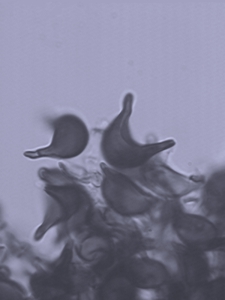Arthrinium

Arthrinium is a cosmopolitan filamentous fungus isolated from plant debris and soil. It is a contaminant, found commonly on dead plants and in soil. Generally it is not considered to have much health significance, but one species is reported to be an allergen. IAQ significance relates to that it will grow in the same conditions as Stachybotrys (wet cellulose) and amplified amounts in indoor air could be a warning that conditions do exist for Stachybotrys growth. It grows rapidly, reaching a colony size of 3 to 9 cm in diameter following incubation at 25°C for 7 days on potato glucose agar. The colonies are woolly to cottony and white with brown spots on the surface. The reverse side is pale. The hyphae are septate and hyaline and bear pale, short or elongated conidiogenous cells which appear inflated at their base where they originate from the hyphae. From these conidiogenous cells, brown, lens- or lentil-shaped conidia are formed in clusters. The conidia typically have germ slits passing through the two poles. Compare to Stephanosporium. Some Arthrinium strains may sporulate slowly and require differentiation from dermatophytes and dimorphic fungi. The conidia of Arthrinium are in clusters, whereas those of Stephanosporium are in chains. Arthrinium is sensitive to cycloheximide. This property helps in differentiation from dermatophytes and dimorphic fungi.